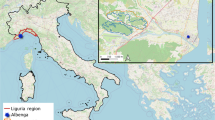Abstract
The accuracy of Cellular Automata (CA) methods for simulating wildfires is limited by the fact that spread directions are constrained to the few angles imposed by the regular lattice of cells. To mitigate such problem, this paper proposes a new CA in which a local randomization of the spread directions is explicitly introduced over the lattice. The suggested technique, inspired by a method already used for simulating lava flows, is empirically investigated under homogeneous conditions and by comparison with the vector-based simulator FARSITE. According to the presented results, the adopted randomization seems to be able to significantly improve the accuracy of CA based on a standard center-to-center ignition scheme.
Access this chapter
Tax calculation will be finalised at checkout
Purchases are for personal use only
Preview
Unable to display preview. Download preview PDF.
Similar content being viewed by others
References
Finney, M.A.: FARSITE: fire area simulator-model development and evaluation. Technical Report RMRS-RP-4, USDA, Forest Service (February 2004)
Tymstra, C., Bryce, R., Wotton, B., Taylor, S., Armitage, O.: Development and structure of Prometheus: the Canadian wildland fire growth simulation model. Technical Report NOR-X-417, Canadian Forest Service, Edmonton, Alberta (2010)
Peterson, S.H., Morais, M.E., Carlson, J.M., Dennison, P.E., Roberts, D.A., Moritz, M.A., Weise, D.R.: Using HFIRE for spatial modeling of fire in shrublands. Technical Report PSW-RP-259, USDA, Forest Service, Pacific Southwest Research Station, Albany, CA (2009)
French, I., Anderson, D., Catchpole, E.: Graphical simulation of bushfire spread. Mathematical Computer Modelling 13, 67–71 (1990)
French, I.: Visualisation techniques for the computer simulation of bushfires in two dimensions. Master’s thesis, University of New South Wales - Australian Defence Force Academy. Dept. of Computer Science (1992)
Cui, W., Perera, A.H.: A study of simulation errors caused by algorithms of forest fire growth models. Technical Report 167, Ontario Forest Research Institute (2008)
Johnston, P., Kelso, J., Milne, G.: Efficient simulation of wildfire spread on an irregular grid. International Journal of Wildland Fire 17, 614–627 (2008)
O’Regan William, G., Peter, K., Shirley, N.: Bias in the contagion analog to fire spread. Forest Science 22 (1976)
Trunfio, G.A., D’Ambrosio, D., Rongo, R., Spataro, W., Gregorio, S.D.: A new algorithm for simulating wildfire spread through cellular automata. ACM Trans. Model. Comput. Simul. 22(1), 6 (2011)
Miyamoto, H., Sasaki, S.: Simulating lava flows by an improved cellular automata method. Computers & Geosciences 23(3), 283–292 (1997)
Rothermel, R.C.: A mathematical model for predicting fire spread in wildland fuels. Technical Report INT-115, USDA, Forest Service, Intermountain Forest and Range Experiment Station, Ogden, UT (1972)
Rothermel, R.C.: How to predict the spread and intensity of forest and range fires. Technical Report INT-143, USDA, Forest Service, Intermountain Forest and Range Experiment Station, Ogden, UT (1983)
Vasconcelos, J., Zeigler, B., Pereira, J.: Simulation of fire growth in GIS using discrete event hierarchical modular models. Advances in Remote Sensing 4(3), 54–62 (1995)
Lopes, A.M.G., Cruz, M.G., Viegas, D.X.: Firestation - an integrated software system for the numerical simulation of fire spread on complex topography. Environmental Modelling and Software 17(3), 269–285 (2002)
Hu, X., Ntaimo, L.: Integrated simulation and optimization for wildfire containment. ACM Trans. Model. Comput. Simul. 19(4), 1–29 (2009)
Trunfio, G.A.: Predicting Wildfire Spreading Through a Hexagonal Cellular Automata Model. In: Sloot, P.M.A., Chopard, B., Hoekstra, A.G. (eds.) ACRI 2004. LNCS, vol. 3305, pp. 385–394. Springer, Heidelberg (2004)
Andrews, P.: BEHAVE: fire behavior prediction and fuel modeling system - burn subsystem, part 1. Technical Report INT-194, USDA, Forest Service (1986)
Anderson, H.: Predicting wind-driven wildland fire size and shape. Technical Report INT-305, USDA, Forest Service (1983)
McAlpine, R., Lawson, B., Taylor, E.: Fire spread across a slope. In: Proceedings of the 11th Conference on Fire and Forest Meteorology, pp. 218–225. Society of American Foresters, Bethesda (1991)
Blecic, I., Cecchini, A., Trunfio, G.A.: A general-purpose geosimulation infrastructure for spatial decision support. Transactions on Computational Science 6, 200–218 (2009)
Forthofer, J., Shannon, K., Butler, B.: Simulating diurnally driven slope winds with windninja. In: Proceedings of 8th Symposium on Fire and Forest Meteorological Society - Kalispell, MT (2009)
Author information
Authors and Affiliations
Editor information
Editors and Affiliations
Rights and permissions
Copyright information
© 2012 Springer-Verlag Berlin Heidelberg
About this paper
Cite this paper
Avolio, M.V., Di Gregorio, S., Lupiano, V., Trunfio, G.A. (2012). Simulation of Wildfire Spread Using Cellular Automata with Randomized Local Sources. In: Sirakoulis, G.C., Bandini, S. (eds) Cellular Automata. ACRI 2012. Lecture Notes in Computer Science, vol 7495. Springer, Berlin, Heidelberg. https://doi.org/10.1007/978-3-642-33350-7_29
Download citation
DOI: https://doi.org/10.1007/978-3-642-33350-7_29
Publisher Name: Springer, Berlin, Heidelberg
Print ISBN: 978-3-642-33349-1
Online ISBN: 978-3-642-33350-7
eBook Packages: Computer ScienceComputer Science (R0)




